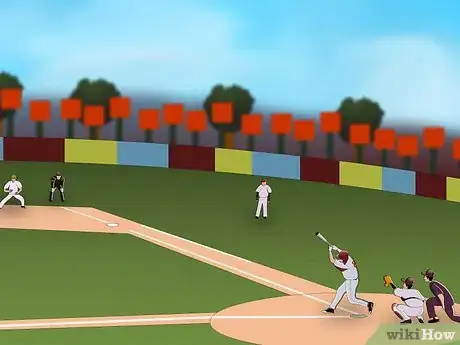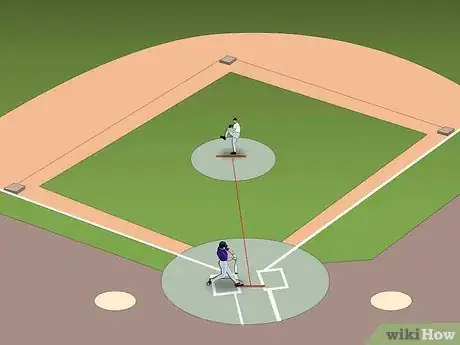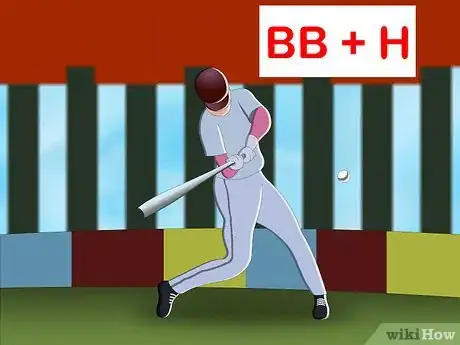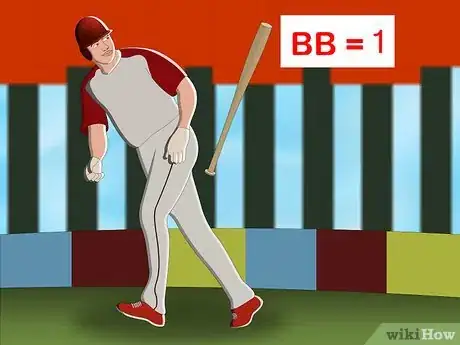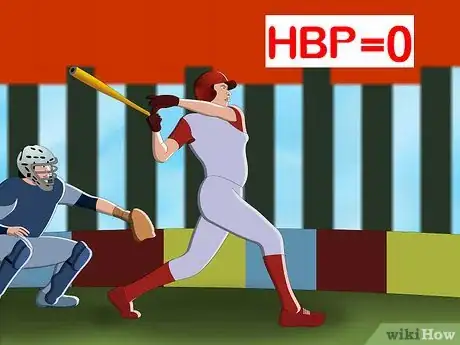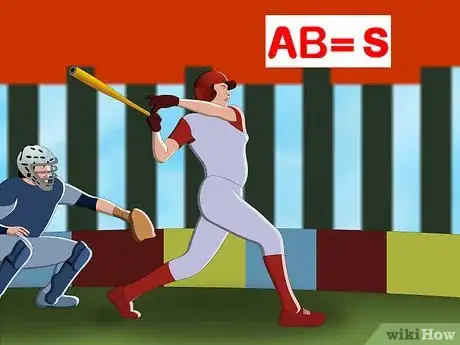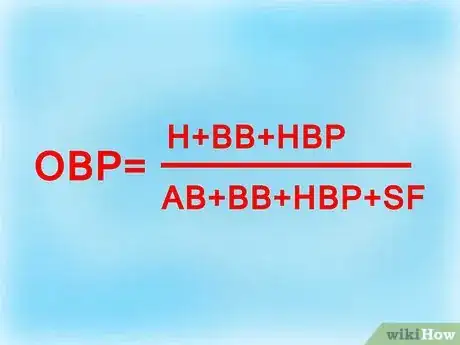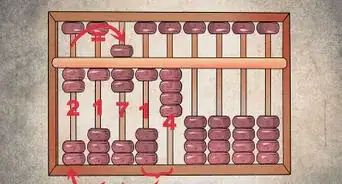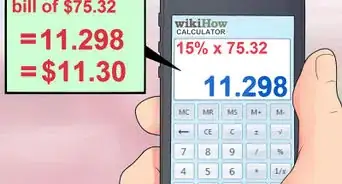X
wikiHow is a “wiki,” similar to Wikipedia, which means that many of our articles are co-written by multiple authors. To create this article, volunteer authors worked to edit and improve it over time.
There are 8 references cited in this article, which can be found at the bottom of the page.
This article has been viewed 24,699 times.
Learn more...
The on base percentage (OBP) is a statistical formula used primarily in baseball and softball. It indicates how often, overall, a batter reaches a base (or, put another way, how often, overall, a batter avoids an out). Once you understand the basics, using the formula to calculate OBP is simple. Scroll to Step 1 to learn more.
Steps
Method 1
Method 1 of 2:
Part 1: Learning the Fundamentals
-
1Recognize the major parts of a baseball field. The field is made up of an infield, an outfield, a pitcher’s mound, 3 bases, and home plate.
- The infield is the diamond-shaped part of the field bounded by home plate (where the batter stands to hit) and the three bases (first base, second base, and third base).
- The outfield is the part of the playing area located outside the diamond-shaped infield.
- The pitcher’s mound is a small hill in the middle of the infield, where the pitcher stands.
-
2Understand “at bats.” Whenever a batter appears at home plate, he earns an “at bat” (AB).[1]Advertisement
-
3Know the definition of a hit. When a batter hits the ball into the infield or outfield and reaches a base safely, he earns a hit (H).[2]
- When a batter hits the ball outside the foul lines that serve as boundaries for the playing field, this is not a hit – it’s a foul.
-
4Understand how “base on balls” works. When a batter receives four pitches that are “balls” – that is, they were outside of the strike zone, where the pitcher must aim to get a strike – then he walks to first base. This is known as a “base on balls” (BB).[3]
-
5Be aware that batters hit by pitches also get on base. If a batter or his equipment is hit by a pitch, then he walks to first base. This is known as a “hit by pitch” (HBP).
-
6Recognize the sacrifice fly. When a batter hits the ball into the air, sacrificing his own at bat in order to give a teammate already on base the opportunity to score, this is called a “sacrifice fly” (SF). A player from the opposing team may catch the ball in the air, meaning that the batter is out, but another player may get to advance or score.
Advertisement
Method 2
Method 2 of 2:
Part 2: Calculating On Base Percentage
-
1Determine the number of hits. Recall that a batter earns a hit (H) when he hits the ball into fair territory and safely reaches first base.[4]
- As an example, take Charles Cobb Blackmon of the Colorado Rockies. Say that when he played against the San Francisco Giants, he scored 2 hits. In this case, H would equal 2.
-
2Find the number of bases on balls. Once you’ve noted the number of hits, note also the number of times the player reached first base because he received four pitches outside the strike zone.
- In the example above, Charles Cobb Blackmon was walked just once. In this case, BB would equal 1.
-
3Note the number of times the player was hit by a pitch. In addition to hits and bases on balls, you need to know if the player ever reached base because he was hit by a pitch.[5]
- In the example above, Charles Cobb Blackmon did not get hit by a pitch. Therefore, HBP would equal 0.
-
4Count the number of at bats. In order to determine the on base percentage, you need to know how many times the player batted. Most batters will stand to hit 4 or 5 times during a game, but there is tremendous variation here.[6]
- In the example above, Blackmon stood to bat 5 times, so AB would be equal to 5.
-
5Factor in the number of sacrifice flies. If the player hit any sacrifice flies, you need to know that to determine the on base percentage.
- In the example above, Blackmon did not hit any sacrifice flies. SF would therefore equal 0.
-
6Plug your values into the OBP formula. To find the on base percentage, you add the players hits, hits by pitch, and bases on balls together; you then divide that number by the sum of the at bats, hits by pitch, bases on balls, and sacrifice flies. The formula looks like this.
- In the example above, you would plug Blackmon’s stats into the formula. Here are his relevant stats.
You would add H + BB + HBP to get 3, and AB + BB + HBP + SF to get 6. Then divide 3 by 6. Blackmon’s OBP for this particular game was therefore 0.5.
- In the example above, you would plug Blackmon’s stats into the formula. Here are his relevant stats.
Advertisement
Community Q&A
-
QuestionIf I only come up to bat once and draw a walk, using this formula my OBP reflected as 0.5. Why is it not 1.0?
 DonaganTop AnswererThe above article does not explain that "AB" in the formula refers to "official at bats." A walk (BB) is not an "official" at-bat. Therefore, in your case, the formula would be OBP = (0 + 1 + 0) / (0 + 1 + 0 + 0) = 1/1 = 1.0.
DonaganTop AnswererThe above article does not explain that "AB" in the formula refers to "official at bats." A walk (BB) is not an "official" at-bat. Therefore, in your case, the formula would be OBP = (0 + 1 + 0) / (0 + 1 + 0 + 0) = 1/1 = 1.0. -
QuestionDo I calculate a sacrifice bunt in my on-base percentage?
 DonaganTop AnswererNo, sacrifice bunts are not included in the calculation, because they do not reflect on a batter's ability to reach base safely.
DonaganTop AnswererNo, sacrifice bunts are not included in the calculation, because they do not reflect on a batter's ability to reach base safely. -
QuestionWhat if I reach base by catcher's interference or fielder's choice?
 DonaganTop AnswererThe above article does not mention catcher's interference, because it is such a rare event. It would be treated similarly to a "hit by pitch," and would thus increase a batter's on-base percentage. A fielder's choice is a unique situation in the sense that the batter reaches first base safely but does not increase his/her on-base percentage, because a teammate is put out at another base (so that, from the batter's team's perspective, nothing good happened on the play).
DonaganTop AnswererThe above article does not mention catcher's interference, because it is such a rare event. It would be treated similarly to a "hit by pitch," and would thus increase a batter's on-base percentage. A fielder's choice is a unique situation in the sense that the batter reaches first base safely but does not increase his/her on-base percentage, because a teammate is put out at another base (so that, from the batter's team's perspective, nothing good happened on the play).
Advertisement
References
- ↑ http://m.mlb.com/glossary/standard-stats/at-bat
- ↑ http://m.mlb.com/glossary/standard-stats/hit
- ↑ https://baseballrulesacademy.com/user/official-rules/mlb/9-14-base-balls/
- ↑ https://www.baseball-reference.com/bullpen/On_base_percentage
- ↑ http://m.mlb.com/glossary/standard-stats/on-base-percentage
- ↑ https://www.homerunweb.com/onbase.html
- http://www.homerunweb.com/onbase.html
- http://www.baseball-reference.com/bullpen/On_base_percentage
About This Article
Advertisement


